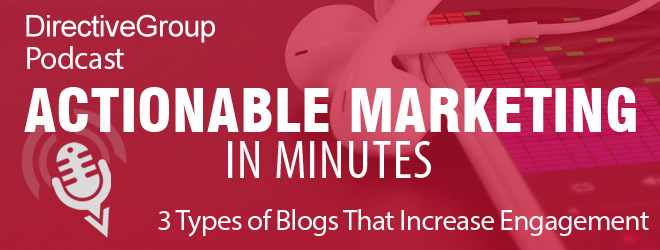In this episode of Actionable Marketing In Minutes we talk about 3 Different Types of Blogs Post that Increase Engagement – the Rant, the Case Study and the How To.
Use the player below to listen to this episode, or the download link to load it on your device for listening later. You can also find our RSS feed by clicking here, or subscribe by email in the sidebar to the left.
Download our Marketing To Millennials eBook here!
Not able to listen? Why not read the episode transcript below:
Problem:
If you run a blog for your business, then you most definitely want to write articles that people love to read! But it can be a real challenge to keep coming up with new ideas and different forms of content that attract and engage audiences. When done well, the right type of blog content can draw prospective customers in, help address their problems, and build a relationship with your brand. The trick is to create a spread of awesome goal-driven content for your blog that directly addresses the needs of your target market. So what are some of the new types of content you can experiment with to stimulate your prospects?
Solution:
You can prevent a content rut with these three types of blog posts – The Rant, The Case Study and The How To! Let me explain what we mean by each.
1. The Rant
In the social media world, emotion rules supreme. If you can develop content that engages and connects with your audience on an emotional and personal level then you are more likely to grab their attention. You can pour your heart out onto the page and share your ideas and experiences with the world.
People connect with human experiences more than a business pitch. So if you are good at whingeing and writing long-winded rants about what you’ve been through, go for it! Just be warned: Rants can cause controversies sometimes but they are more likely to trigger online debate and discussions. Rant posts work as an outlet for readers also, as it encourages them to communicate how they feel too. From a business perspective, posts like this go a long way in building trust with your audiences, and it can ultimately lead to them buying from you.
2. The Case Study
People are more likely to believe what you’re talking about when you illustrate your point with examples. Case studies lend themselves to storytelling. And any story is more relatable when it is about real people. When something is shown to you through the failures and successes of others, it seems to click with audiences. For instance, you can detail the journey of your users who tasted success with your products or services. Make the story about them and not just your product. Case study blog posts show real life examples of a topic that is valuable to your audience and are therefore great for lead conversions.
3. The How To
People generally go online to discover how to do something, whether it is learning how to bake a cake, brew home beer, or do DIY decor. They’re looking to acquire information about something or get solutions to their real problems. If you have the answers they’re looking for, then they’re likely to click on the link to your site to read the post.
Long textual guides however can be difficult to read, so break the information into smaller detailed guides with images, bullet points, infographics, video, or audio to enrich the post. By sharing your knowledge, you also increase your chances of being seen as an industry expert. No wonder, How To’s are awesome for creating brand awareness and generating leads.
Benefit:
You obviously have more than the three types of blog posts we have discussed today at your disposal for business blogging. You can never run out of interesting information to share with your audience. So all you have to do is find different ways of presenting content on your blog to spark engagement and achieve audience interaction.
We hope you’ve found this information helpful. Please connect with us on Twitter @DirectiveGroup or on LinkedIn. Let us know what you think and what you’d like to hear about next. And if you like our podcasts please share with your networks using hashtag #actionablemarketing.
Join us for an upcoming episode where we discuss “How to evaluate the quality of your content.”
Podcast: Play in new window | Download (Duration: 5:07 — 2.2MB) | Embed
